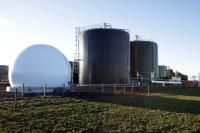 Add My Company
Add My Company
Sign In

At KTR, we have been focusing our attentions to renewable energy sources. The promise of a clean solution to fossil fuels is most commonly associated with wind power and solar energy but it's been suggested that biogas could actually be the way forward. Could this less publicised form of renewable energy be the future of sustainable energy in the UK?
At KTR our products link us to anaerobic digestion - a biomass to biogas process - therefore we want to discuss this as a possible future addition to the UK's renewable energy efforts.
The EU has set a policy for renewable energy, which has a fixed goal of supplying 20% of European energy from renewable resources by 2020. The majority of this energy will originate from European farming and forestry via biomass conversion / anaerobic digestion.
What is Anaerobic Digestion?
Anaerobic digestion (AD) is a way of reducing carbon emissions by breaking down organic materials into methane and carbon dioxide gas and fertiliser, either naturally or in an anaerobic digester.
Anaerobic Digester (Source: One North East)
As you can see from the image above, an anaerobic digestion system consists of a number of sealed vessels that contain a warm mixture of organic material that is starved of oxygen, allowing bacteria to begin breaking down the biomass. Almost anything can be added to the anaerobic digester; agricultural waste from animals or human consumption items, such as food and garden waste, can all be digested to generate biogas and nutrient rich fertiliser.
A mixture of gases is formed during the process, which are collectively named biogas. This is made up of 70% methane and 30% carbon dioxide. The next stage is to remove the carbon dioxide, and the remaining methane is used as renewable natural gas or biomethane.
Biomethane can be produced within days and has a number of varied uses such as fuel for heating, cooling and fertilising. As biomethane is made from organic, natural materials it is the world's cleanest, most environmentally friendly fuel and it's use could significantly help to reduce greenhouse gas emissions. No wonder the UK wants to promote anaerobic digestion as the future of renewable energy to cut down on our fossil fuel usage!
The extracted carbon dioxide is also put to use based on its properties as an inert gas for heat transfer. It is used in fire extinguishers, carbonation of soft drinks, shield glass in welding and oil extraction.
Where is biogas already being used?
The German government are already using biogas as a renewable energy, and it is reported to supply almost 8% of their electricity and heat, where as solar energy produces 0.3% and wind power 2%. There are 6,800 anaerobic digestion plants in Germany, and they supply 5 million homes with power, create €6 billion in revenue and employs 20,000 people. Projections of biomass growth by 2020 show significant improvements in the number of plants and the number of people employed. Perhaps another example of why the UK should embrace biomass as a renewable energy.
The USA is also embracing biogas as a renewable energy source, however they are not putting their extensive agricultural land to its best use. They have fourteen times the expanse of Germany and eight times as many cattle, allowing the USA to potentially power 20 million homes, create $26 billion in revenue and employ 260,000 people.
As well as agricultural waste, the USA produce millions of tonnes of organic waste from left over food and sewage etc. This is discarded each year into landfills, which incurs costs for collection, transportation and disposal. A big problem in dumping this waste into landfill sites is that as the material breakdowns it produces methane (a strong greenhouse gas if it is emitted into the atmosphere directly). Some landfills do have gas capture systems in place, but gases can escape and not all systems can use the gas to generate electricity or fuel.
Anaerobic digestion systems can be built on farmland of varying sizes, and help create additional income for millions of farmers. By using biomass material, it is possible to produce over 30 million MWh of electricity that could save money on waste management, creating jobs and increase revenue.
Undoubtedly, biogas cannot reach the 20% goal set by the EU alone, but alongside solar energy and wind power, this should certainly be achievable.
KTR Couplings are a leading manufacturer and supplier of flexible couplings, gear couplings, power transmission couplings and brake systems. Please get in touch if you would like a free consultation or any further information on any of our products.
For more information on Anaerobic Digestion - The Future of Renewable Energy? talk to KTR U.K. Ltd
Enquire Now
List your company on FindTheNeedle.

